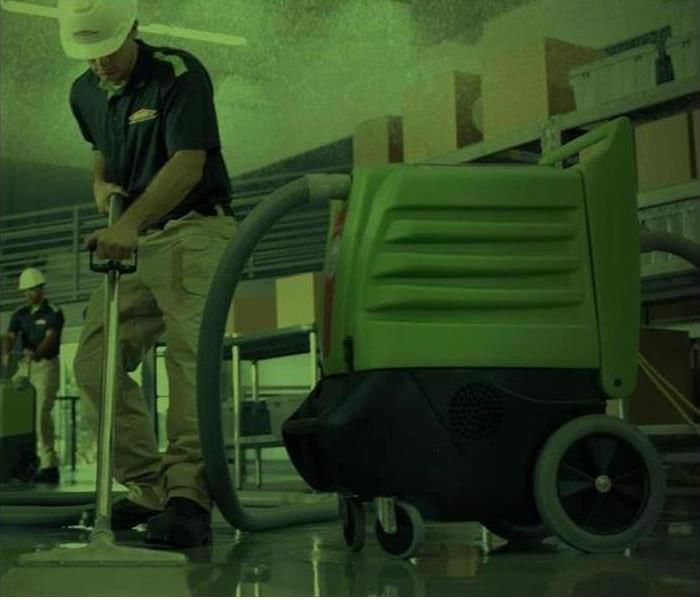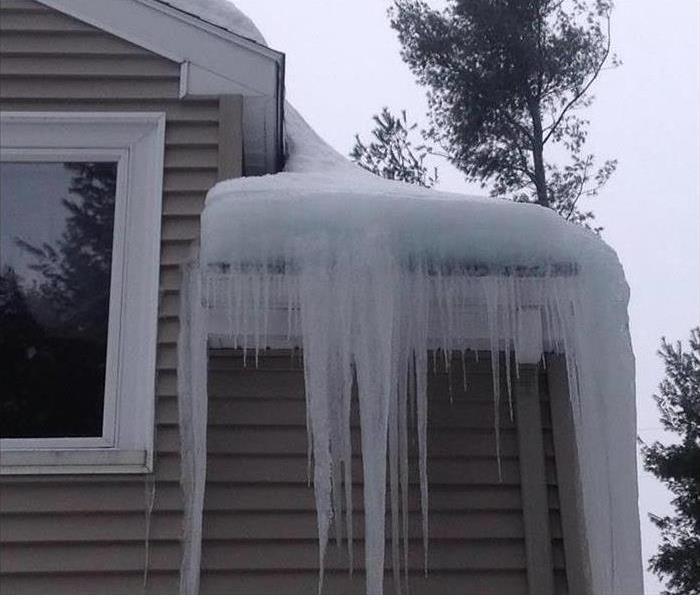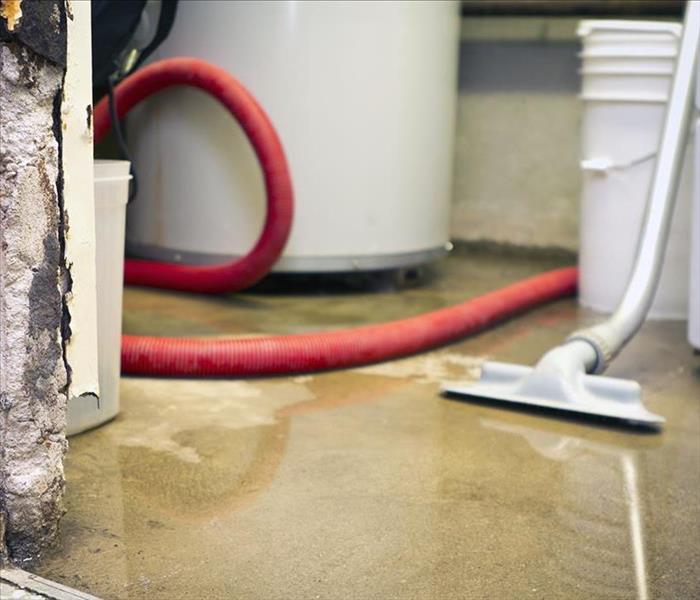Recent Water Damage Posts
Rapid Recovery: Water Damage Restoration Experts in North Platte, NE
4/1/2024 (Permalink)
Water damage will disrupt your daily life, but at SERVPRO of Kearney and North Platte, serving the North Platte, NE area, we're here to help you restore your property quickly and effectively.
When water damage occurs, our dedicated team offers round-the-clock emergency response to ensure prompt mitigation and minimal disruption to your daily life. Using state-of-the-art equipment and techniques, we extract water, dry affected areas, and prevent mold growth for thorough and efficient restoration. We understand that every water damage situation is unique, which is why we tailor our solutions to address the specific needs and concerns of each client.
Don't let water damage disrupt your life. Trust SERVPRO of Kearney and North Platte for professional water damage restoration services in North Platte, NE.
How to Avoid Frozen Pipes
11/1/2021 (Permalink)
Once the summer temperatures fall and cooler weather settles in, there are many possible causes of water damage for business owners to consider. One of the most important situations to avoid is the damage that happens after freezing temperatures lead to broken pipes.
Prevent Frozen Pipes
Before jumping into the steps to take after the damage has happened, consider some steps you can take to protect your pipes and, hopefully, prevent them from breaking:
Identify areas of possible weakness, such as pipes that are exposed to the weather, pipes in unheated parts of the building, and unprotected pipes along exterior walls.
Drain water from hoses and pipes that won't be used during cold weather, such as the sprinkler system.
Remove exterior hoses and store them inside. Drain hoses and pipes before storing them for the winter.
Add insulation to exterior walls, basements, and other cold rooms in the building.
Consider products such as pipe sleeves and insulated covers. These protective covers could provide just enough warmth to keep water running when it's needed.
Remember that water expands when it freezes, so when the water in a pipe becomes cold enough to freeze, there's a lot of pressure from the inside of the pipe. The steps you can take to prevent broken pipes are effective ways to avoid a lot of water damage.
Keep Your Pipes Warm During the Winter
There are several other steps you can take to protect your commercial property in the Kearney and North Platte area. These include setting your nighttime thermostat to a temperature above freezing, letting a small amount of cold water drip from the faucets during very cold weather, and opening cabinet doors to allow heated air to flow freely around the pipes. If your business is going to close for several days or longer, turn off the water to the building. Otherwise, you may return to serious flooding and the need for expensive water cleanup.
Respond to Frozen Pipes
Sometimes, in spite of your efforts, the pipes may still freeze. Even if there's no obvious damage, you may find that just a small trickle is all you're getting from the faucet. This is a clear sign that the pipes are frozen:
Leave the faucet open and begin looking for the section that's frozen.
Use a space heater, electric heating pad, or another gentle source of heat to treat the frozen section of the pipe. You could also warm up some towels to wrap around the pipes. As you slowly thaw the ice inside the pipes, you'll see a stronger flow of water from the faucet. Don't ever use any open flame, blowtorch, or propane heater to warm up the pipes.
Continue applying gentle heat until you have full water pressure from the faucet.
If you have one frozen pipe, there's a good chance that there are other clogged areas in the pipes. Test all of the faucets on your property.
If a burst pipe has caused serious water damage, contact local cleanup and reconstruction professionals. The sooner you respond to flooding and damage, the better you can avoid further expense and inconvenience.
Water in a Light Fixture?
11/1/2021 (Permalink)
A flood from a busted pipe or supply line leak can affect more than just the surrounding area. This is particularly common when the faulty water source is on the second story of your home in the Kearney and North Platte area. Not only can it cause water damage to the flooring and walls around it but also to the ceiling under it. Here are a few tips for getting the water out of the light fixture on your lower floor effectively and efficiently.
2 Tips To Deal With Water in a Light Fixture
1. Stay Safe
Your gut reaction may be to open up the fixture and just let the water drain out. This is not advisable until you have taken the necessary safety precautions:
- Shut off water to stop flooding.
- Flip breaker to cut power.
- Don rubber gloves and boots to neutralize residual charge.
Draining the fixture is one of the first steps toward taking care of the water damage to your lower floor. If you choose to touch the light before the restoration team arrives, make sure you are doing it safely.
2. Call Professionals
If the leak in your home has flooded two floors, you need water damage repair that goes beyond amateur abilities. When water has made its way into a light fixture on a lower level, you probably have quite a bit of ceiling damage on top of everything that needs mitigation on the higher floor. You need a team that has the experience and expertise to address the whole problem. As soon as you know there is an issue, call local water restoration specialists. They can assess the problem, propose solutions and provide an estimate of how much time and money it will probably take to fix it.
Water damage doesn't always stick to one area of your home. The more water involved, the farther and faster it can spread. It may even flood a lower floor, including the ceiling and light fixtures. Use the appropriate safety precautions and call for the help you need.
Stopping a Water Leak Before it Becomes a Problem
10/4/2021 (Permalink)
A water leak in your business should never be ignored. Whether from a plumbing leak, an appliance malfunction, or a leaky roof or windows, even a small amount of excess water can lead to significant water damage repair costs. That’s why it’s important to identify leaks and take quick action to correct them. Use the following tips from SERVPRO to stop small leaks from becoming a big problem.
HOW TO SPOT SIGNS OF A PLUMBING OR ROOF LEAK
Water can get into your building in a variety of ways, and two of the main culprits are roof leaks and plumbing leaks. One of the tell-tale signs of a leak in your plumbing system is an unexpected increase in your water bill. If your water bill seems high, inspect your building for the following:
- Leaking pipe joints or P-traps underneath sinks.
- Leaks around appliances that use water.
- Corrosion on supply lines to appliances and fixtures.
- Stains below supply line connections.
- Broken toilet tank flappers.
- Odd smells coming from drains, which may indicate a sewer leak.
- Warped or discolored flooring.
- Water stains on the walls and ceilings directly below bathrooms.
Water stains on walls and ceilings can also be indicators of a roof leak. Other signs of water damage can include a musty smell in the attic, peeling paint around skylights, deteriorating drywall, missing or damaged shingles, and damaged flashing.
WHAT TO DO IF YOU FIND SIGNS OF WATER DAMAGE
Some leaks are, thankfully, fairly easy to fix. A leaky toilet may just require a new flapper valve, while a leaky faucet could need a new O-ring. If the leak requires more than a simple fix, however, call in a professional to address the issue and keep your water damage repair costs to a minimum.
In the event of a plumbing or appliance leak, you can mitigate the damage while you wait for the professionals to arrive. Start by shutting off the local water supply at the site of the leak. Here are the usual shut-off valve locations for some common fixtures and appliances:
- Sink: Just below the sink, next to the water supply lines. Sinks will typically have two shut-off valves, one for hot water and one for cold water.
- Dishwasher: Also under the sink, likely close to the sink shut-off valves.
- Toilet: Close to the toilet and near the floor, as part of the water supply line.
- Refrigerator with water and ice dispensers: On the supply tube running to the refrigerator, likely behind the refrigerator or under a nearby sink.
You can also lessen the potential for long-term damage by mopping or soaking up any standing water in the area of the leak. Keep in mind, however, that where there’s a water leak there’s often mold growth, so if you discover a mold outbreak it’s best to leave cleaning and remediation up to the experts. A professional water damage cleanup service like SERVPRO will know exactly how to address the problem before it gets worse.
Even seemingly insignificant water leaks can be signs of a larger issue. Don't let these problems continue unaddressed. Take steps to identify and stop water leaks at your place of business, and then contact the remediation experts at SERVPRO to make sure your business stays safe and clean for everyone who walks through the door.
Fixing a Running Toilet
10/4/2021 (Permalink)
You’re probably familiar with that notorious sound that emanates from a constantly running toilet. While certainly annoying, a toilet that runs continuously can also be costly in many ways. From a huge water bill to potential flooding or a damaged septic system, running toilets are often more than just a nuisance.
It’s important to know what causes a running toilet, and what you can do to fix it before it becomes a much more serious problem. Read on to find out the basics of toilets that run too frequently, and why this is one repair you definitely don’t want to put off.
What Causes a Running Toilet?
A constantly running toilet is generally an indication that one or more internal components of the toilet tank has malfunctioned. Luckily, these issues can be easy to diagnose, and fixing a toilet that runs is something you can often do yourself. Remove the lid from the tank and inspect the following:
- Fill Valve or Ballcock: Your tank will include either a cylindrical fill valve or a round ballcock that is designed to shut off water flow once the tank has filled up. If water is continuously escaping down the overflow tube, you may need to adjust the fill valve or ballcock to reduce the amount of water it allows into the tank.
- Flapper: This part creates a seal around the flush valve, through which water flows into the toilet bowl. Ensure that the flapper is not worn, chipped or hardened. Make sure the chain coming off the flapper has not gotten caught or tangled, and that it has adequate slack to allow the flapper to close automatically after the handle is released.
- Flush Valve: Like the flapper, this part can become rough or eroded over time, allowing water to slowly drain into the bowl and causing the tank to periodically refill.
- Flush Lever: This includes the toilet handle and the arm inside the tank. Make sure they are tightly secured and in good condition.
The Major Risks of Minor Leaks
Whatever the cause, it’s a good idea to fix a running toilet as soon as you’re aware of the problem. For starters, a constantly running toilet can waste a substantial amount of water, setting you up for a nasty surprise when the next water bill arrives. Beyond that, a toilet that runs all the time is at greater risk of overflowing and causing substantial flooding damage, with overflow being among the leading causes of toilet failures, according to the Insurance Institute for Business and Home Safety.
For those on septic systems, a running toilet introduces additional risks. Constant water flow can flood your septic tank and can eventually cause the drain field to saturate and fail. This can lead to health effects as well as costly mitigation and repair efforts that, as with a flooded home, far exceed what it would have cost to repair a leaking toilet in the first place.
If you have a toilet that won’t stop running, don’t wait for the problem to get out of hand. Understanding the basics of toilet operation and what you can do to fix yours can mean the difference between an easy repair and expensive damage. If you do end up dealing with a toilet overflow and damage to your home, you can count on the experts at SERVPRO to help make it right. We’re available 24/7/365 to answer your questions and help you return to a clean, healthy home as soon as possible.
Main Water Valve Leaking?
10/4/2021 (Permalink)
As a homeowner, it's essential to know where the main water shut off valve is located. Water leaks from running toilets, burst pipes, broken water heaters, and even leaky sinks can cause significant damage in a short amount of time. In order to prevent costly damage, turn off the water supply as soon as a leak, flood, or spill occurs.
Find out how to maintain all your valves throughout the year, including the ones connected to your sinks and toilets, plus tips on when it's best to completely shut off your main water line from the experts at SERVPRO.
WHEN DO I NEED TO SHUT OFF MY MAIN WATER LINE?
Typically, you won't have to go directly to the main water line to fix a leak. Instead, your first attempt at stopping your water supply should be straight at the source. Most local supply lines have valves located directly behind or above the fixture and can be turned clockwise to shut off the water supply.
To locate water valves next to specific fixtures in your home, use these tips:
- For sinks, look under the cabinet on the supply lines leading to the faucet. There will likely be two shut-off valves to control both cold and hot water.
- For toilets, look close to the ground behind or beside the toilet, along the flexible metal tubing leading to the tank.
- For washing machines, look either directly above the washer or pull the machine away from the wall and check behind it.
- For water heaters, the water valve should be located just above the heater itself.
Operating these valves can vary depending on their design. There may be a round or oval-shaped valve handle that you turn clockwise to close, and counterclockwise to reopen. Some modern plumbing shutoff valves may feature a flat knob that you pull out in order to close. Others may look like flat levers, which you can turn perpendicular to the supply line to reach the closed position. In many cases, operating instructions may be indicated directly on the valve.
If the leaky fixture's valves aren't working or break off, turn off your main water line right away. Acting fast could save you plenty in damages and repair costs.
HOW DO I FIND MY MAIN HOUSE WATER SHUT OFF VALVE?
The main water line valve to a house is usually located in the basement or in the crawlspace and enclosed behind an access panel. However, there isn't a standard location specified in any home.
If you don't know where to look for your water shut off valve, use these tips:
- The valve will often be located on-grade, so you'll likely find it at eye-level in the basement or near the ground on the first floor.
- The valve may also be attached to the water meter outside your home. Water meters are generally located close to the street in an underground box or near your driveway, yard or sidewalk.
- Take a look at the property inspection report provided when you purchased your home. This report should note the location of the valve.
MAINTAINING YOUR WATER VALVES
At SERVPRO, we know how terrifying it can be to try shutting off your supply lines just to see the valves stick in place – or worse, snap off in your hands. That's why we recommend periodically checking your shut off valves to ensure they're in good working condition.
At least twice a year, test all the valves in your home. Simply turn them completely off and on again to ensure they aren't stuck in place or include faulty parts. That way, if an emergency ever does occur, you can have peace of mind that you'll be able to fix the problem quickly and efficiently.
Make sure every family member knows where these shutoff valves are located so that a minor water incident doesn’t result in major damage. Consider writing out instructions so everyone in the household knows how to act if they spot a leak. When you’re heading out of town, use these valves to shut off water flow so that you don’t come home to water damage or a flood.
If the unexpected happens are you aren’t able to shut off your water valves in time, call on the experts at SERVPRO. Our water damage restoration services can help you get your home back to normal as quickly as possible. With the proper tools and knowledge, we'll work fast and efficiently to prevent additional water damage, cleanup costs, and overall stress.
Catching a Running Toilet Before It Goes Too Far
10/1/2021 (Permalink)
You’re probably familiar with that notorious sound that emanates from a constantly running toilet. While certainly annoying, a toilet that runs continuously can also be costly in many ways. From a huge water bill to potential flooding or a damaged septic system, running toilets are often more than just a nuisance.
It’s important to know what causes a running toilet, and what you can do to fix it before it becomes a much more serious problem. Read on to find out the basics of toilets that run too frequently, and why this is one repair you definitely don’t want to put off.
What Causes a Running Toilet?
A constantly running toilet is generally an indication that one or more internal components of the toilet tank has malfunctioned. Luckily, these issues can be easy to diagnose, and fixing a toilet that runs is something you can often do yourself. Remove the lid from the tank and inspect the following:
- Fill Valve or Ballcock: Your tank will include either a cylindrical fill valve or a round ballcock that is designed to shut off water flow once the tank has filled up. If water is continuously escaping down the overflow tube, you may need to adjust the fill valve or ballcock to reduce the amount of water it allows into the tank.
- Flapper: This part creates a seal around the flush valve, through which water flows into the toilet bowl. Ensure that the flapper is not worn, chipped or hardened. Make sure the chain coming off the flapper has not gotten caught or tangled, and that it has adequate slack to allow the flapper to close automatically after the handle is released.
- Flush Valve: Like the flapper, this part can become rough or eroded over time, allowing water to slowly drain into the bowl and causing the tank to periodically refill.
- Flush Lever: This includes the toilet handle and the arm inside the tank. Make sure they are tightly secured and in good condition.
The Major Risks of Minor Leaks
Whatever the cause, it’s a good idea to fix a running toilet as soon as you’re aware of the problem. For starters, a constantly running toilet can waste a substantial amount of water, setting you up for a nasty surprise when the next water bill arrives. Beyond that, a toilet that runs all the time is at greater risk of overflowing and causing substantial flooding damage, with overflow being among the leading causes of toilet failures, according to the Insurance Institute for Business and Home Safety.
For those on septic systems, a running toilet introduces additional risks. Constant water flow can flood your septic tank and can eventually cause the drain field to saturate and fail. This can lead to health hazards as well as costly mitigation and repair efforts that, as with a flooded home, far exceed what it would have cost to repair a leaking toilet in the first place.
The Power of Dehumidifiers
3/8/2021 (Permalink)
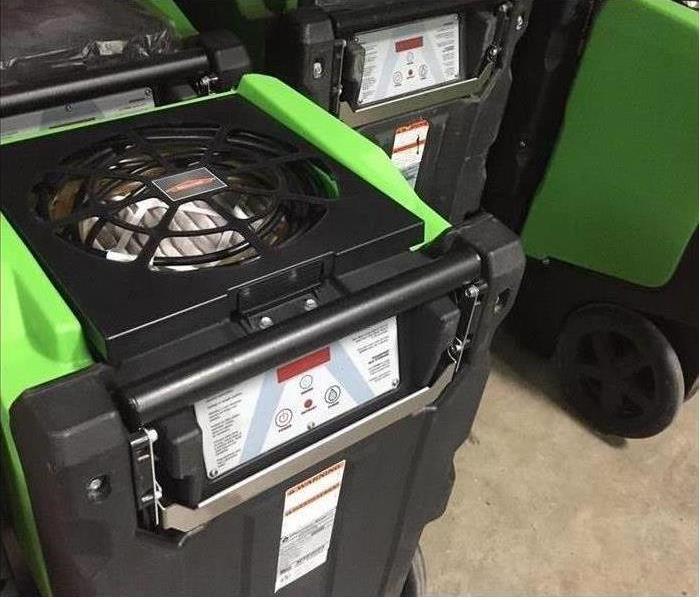 Our team member make sure to come prepared with all the necessary equipment to get the job done in a timely manner.
Our team member make sure to come prepared with all the necessary equipment to get the job done in a timely manner.
We use dehumidifiers as one piece of equipment during our balanced drying system we utilize when we are cleaning up after a water loss. Dehumidification helps to minimize secondary damages. Dehumidifiers used alone are not the only piece of equipment we use. These units are used to capture evaporated moisture in the air. Our team members work to get the moisture out of the material, and they then use air movers and energy to get the water to evaporate. Once evaporated, the vapor can be removed from the air with a dehumidifier. "Dehumidifiers are a sealed refrigeration system with defrost mechanism, fan, and water collection system. The dehumidifier removes energy from the incoming air, then returns this energy as sensible heat to the exiting air. During this energy removal process, water vapor condenses on the evaporator (cool) coil and is collected." - Disaster Academy Training Manual
How to Handle a Water Loss
11/6/2020 (Permalink)
Water damage can affect not only the structure of your house but also your belongings. SERVPRO of Kearney & North Platte understands that your home is more than a structure. Your furniture, clothing, keepsakes, and other belongings are important to you. We provide the following services to help restore and protect your belongings while we are restoring your home.
Contents Restoration
SERVPRO of Kearney & North Platte specializes in restoring contents damaged by water. We pretest your contents to determine what items can be restored back to their condition before the water damage. We utilize several methods of cleaning your contents, including:
Dry Cleaning - Used for cleaning light residues or to pre-clean prior to wet cleaning.
Wet Cleaning - An effective cleaning method for removing moderate to heavy residues.
Spray and Wipe - Effective for items that can’t withstand wet cleaning.
Foam Cleaning - Used for upholstery fabrics that might shrink or bleed if wet cleaned.
Abrasive Cleaning - Involves agitation of the surface being cleaned.
Immersion Cleaning - Contents are dipped into a bath of the cleaning product.
Move-Outs/Pack-Outs
If your home requires extensive restoration, SERVPRO of Kearney & North Platte can conduct an organized, efficient move-out of the affected area. A move-out will provide several benefits, including the following:
A quicker remodeling process
Protecting items from potential damage
Protecting contents from further on-site damage
When restoration is completed, we will work with you to coordinate the move-in according to your needs.
On-Site Storage
We have in-house storage where we can keep your belongings safe from further damage, and can provide cleaning and restoration services for your belongings. We have a warehouse dedicated to storage where we can keep your items safe and secure.
SERVPRO of Kearney & North Platte specializes in the cleanup and restoration of residential and commercial property after a fire, smoke or water damage event. We can handle any size disaster!
Call us at (308)535-1115
Winter Water
11/6/2020 (Permalink)
Winter can be freezing and snowy, more often than not it’s just rainy. But that does not mean that winter weather can’t still take a toll on your home and property. We at SERVPRO of Kearney & North Platte want to make sure you know the correct steps to take to prevent damages to your home and more importantly disruptions to your life. Ensure gutters are clean & secure, leaves & debris that accumulate damage gutters and can lead to roof problems & water damage. If winter and cold weather take their toll on your home, make sure to call the team with the knowledge and experience to make it “Like it never even happened.”
SERVPRO of Kearney & North Platte specializes in the cleanup and restoration of residential and commercial property after a fire, smoke or water damage event. We can handle any size disaster!
Call us at (308)535-1115
Have You Checked Your Sump Pump Lately?
10/28/2020 (Permalink)
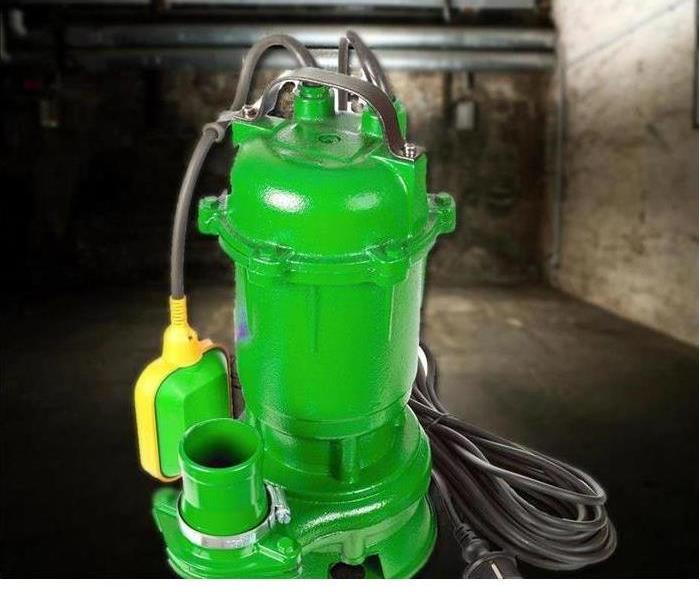 Sump Pump
Sump Pump
A properly functioning sump pump can be the difference between an expensive water damage and a dry basement. There are two types of sump pumps that you may have in your basement: “submersible” pumps are installed under the floor in your basements, while the “pedestal” pump sits above your sump basin. Sump pumps are used to “pump” groundwater away from your home and will evacuate large quantities of water, such as flooding and sewer backups to other areas, such as storm drains. It's important to keep your sump pump in good working order, so it can keep your basement dry all year long. To learn more about sump pump maintenance, check out these common sump pump mistakes people make.
NEGLECT
Simply put, some homeowners never even check on their sump pumps until it's too late. Many homeowners simply ignore routine maintenance and checking their sump pump system on regular intervals. It's possible you may not have a properly functioning sump pump until your basement is several inches under water.
DO IT YOURSELF INSTALL
Have you ever told yourself; "I wish I would have called a professional to do it." If you’ve never installed a sump pump, don’t risk doing it yourself. You'll end up paying a lot more for damages than for the cost of proper installation by a professional installer. Hire a plumbing professional to avoid the risks of faulty installation.
NO BACKUP POWER
During a storm or utility company power outage, your home can lose power, causing your sump pump to shut down. Should you experience flooding in your basement, a sump pump would redirect any incoming water. Keep your sump pump working during a power outage by connecting it to a backup power source, such as a generator or battery backup system.
IGNORING THE DISCHARGE PIPE/FLOAT SWITCH
Check that the drainage pipes are tightly connected and are directed away from your home’s foundation. Also, inspect the pipe for damage and clogs. Seek help at once if you find clogs or damage. Anything that impedes the flow could result in basement flooding due to slow drainage or no drainage at all.
The float switch tells the sump pump motor to stop once the water level goes below the float. Your sump pump needs ample space around the float to both float and sink freely. This should be inspected on a routine basis.
ROUTINE MAINTENANCE
Routine sump pump maintenance goes a long way in guarding against basement flooding. Schedule a thorough inspection with a septic tank maintenance professional or plumber twice a year. For professional water damage restoration or mold removal, contact SERVPRO of Kearney & North Platte.
Wait! Don't Touch That Fan!
10/28/2020 (Permalink)
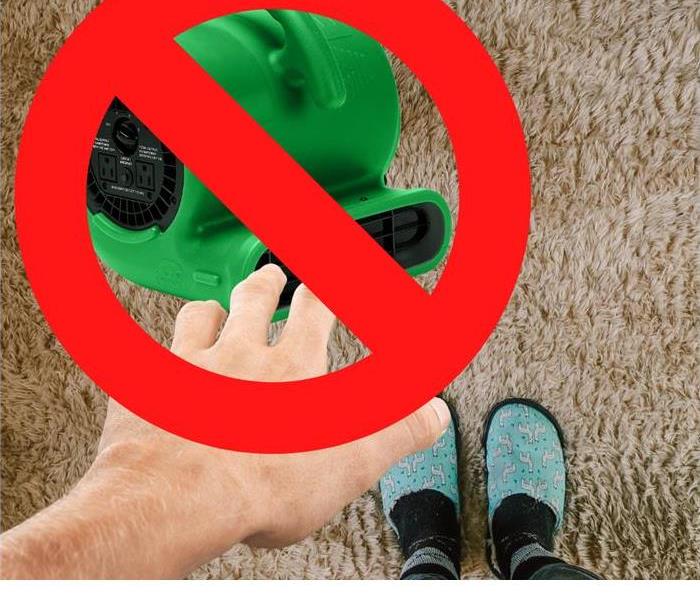 Before touching set equipment, give us a call. We set our equipment with a purpose
Before touching set equipment, give us a call. We set our equipment with a purpose
Let’s set the scene:
SERVPRO of Kearney & North Platte has come to your home after a water damage occurred. Contents have been removed and it is time to start the drying process with to get it back to “Like it never even happened.”
The first thing that will happen is if there is an excess amount of water in the carpet, the technicians will extract that water. After extraction, the flooring will still be damp. This is where we will place our air movers or “fans.”
Did you know that we place the air movers in a specific way that speeds the drying process? The placement of our fans creates the ideal airflow that circulates in dry air from the humidifiers, which evaporates the moisture in the flooring. To the untrained eye, it may not seem that way, but we have a purpose for doing the things the way we do. If you have any questions regarding the process, it is best to direct those questions to the trusted SERVPRO of Kearney & North Platte's team.
If a piece of our equipment stops working while we are not on site, we will need to know as soon as possible so that we can replace the faulty equipment. In this case, also give the lead on your loss from SERVPRO of Kearney & North Platte a call.
Recovering From A Water Damage
10/19/2020 (Permalink)
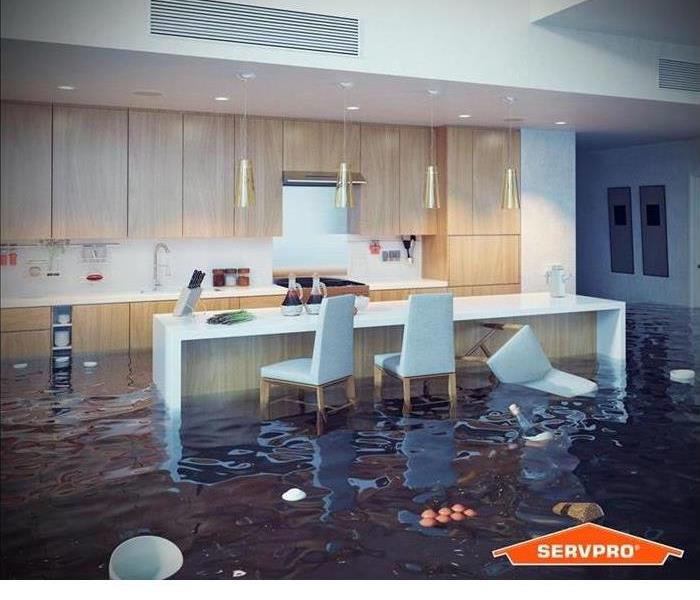 Kitchen Flood
Kitchen Flood
When it comes to water damage in the U.S., almost 40% of homes have incurred losses due to this type of occurrence. Most of these problems are caused by a neglected or damaged roofs, old or faulty plumbing, broken washers and water heaters. Natural disasters such a flood events or hurricanes also ruin homes and businesses with their destructive forces.
During a water damage disaster, many homeowners and businesses feel hopeless, especially if most of the structure is still under water. The situation may appear bleak, but in most cases, there is a great chance of recovering your home or business from water damage quickly. The first step is not to panic. Keep calm and figure out where to begin. This is where an Emergency Plan should be considered before an event like this strikes. Check out https://www.ready.gov/plan. Here are some simple steps to guide you to a successful home recovery after water damage.
The Science of Drying
3/10/2020 (Permalink)
Did you know, there is actually a science behind the process of drying? The knowledge of psychometrics is essential to restoring a water damaged structure to its preloss condition. While your initial reaction may be to grab a few towels to mop up the mess and place a fan or two around the damaged area, SERVPRO of Kearney & North Platte is trained in the science of drying and follow strict industry-approved standards to help lower the chances of any secondary damages. If your business suffers water damage we are here for you. We are dedicated to helping our customers when disaster strikes and helping to make it “Like it never even happened.”
SERVPRO of Kearney & North Platte specializes in the cleanup and restoration of residential and commercial property after a fire, smoke or water damage event; as well as mold remediation. We can handle any size disaster!
Call us today at 308.535.1115





 24/7 Emergency Service
24/7 Emergency Service
